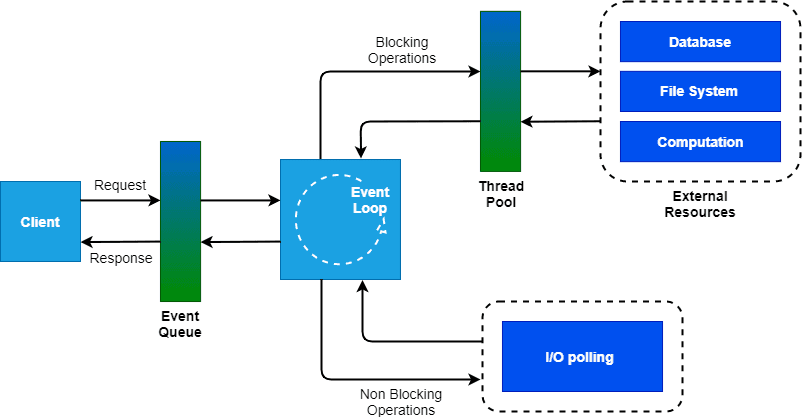How does NodeJS work?
2021-08-15
•
3 min read
NodeJS is an open-source JavaScript runtime environment and library to run web applications outside the client’s browser. It is used to create server-side web applications.
NodeJS is single-threaded for asynchronous processing and takes advantage of the event-driven approach. With synchronous processing, tasks are performed one at a time and only when one is completed. In other words, you need to wait for a task to finish to move to the next one. With asynchronous processing, on the other hand, you can move to another task before the previous one finishes.
By doing asynchronous processing on a single thread under typical web loads, NodeJS can achieve more performance and scalability compared to the typical thread-based implementation.
An event-driven programming approach uses events to trigger various functions. An event can be anything, such as typing a key or clicking a mouse button.
One of the most common terms you will come across and you can never miss out while working with NodeJS is “callback functions”. In NodeJS a callback function is called after a given task. It allows other code to be run in the meantime and prevents any blocking. All NodeJS APIs, therefore, are written to support callbacks.
NodeJS is, therefore, suitable for;
- Real-time and data-driven applications like chats
- Data-Intensive streaming applications like Netflix
- Complex SPAs (Single-Page Applications). These are commonly built with tools such as React and Vue.
- Internet of Things
- And works well with the now-famous Microservices architecture
In summary here are some of the reasons why you should choose NodeJS for your next application.
- NodeJS is generally fast
- NodeJS is asynchronous
- NodeJS rarely blocks
- NodeJS yields great concurrency
- Better synchronization of code between server and client due to same code base
- The Node Package Manager has over 50,000 packages available at the developer’s disposal which make it faster for a developer to deliver a given project since they do not need to write some implementations from scratch
The diagram below illustrates a typical workflow of a web server built with NodeJS

- A client will send requests to the webserver to interact with the web application. A request can be non-blocking (simple operations that do not require external resources, such as querying or updating data from a Postgres database) or blocking (complex operations requiring external resources).
- NodeJS then retrieves the incoming requests and adds them to the Event Queue.
- The requests are then passed one by one through the Event Loop. The event loop checks if the requests are simple enough not to require any external resources If they are simple enough, the Event Loop processes simple requests such as I/O Polling. Once the task is carried out completely, the response is sent to the Event Loop that sends that response back to the client.
- On the other hand, if they are complex, a single thread from the Thread Pool is assigned to a single complex request. This thread is responsible for completing a particular blocking request by accessing external resources. Once the task is carried out completely, the response is sent to the Event Loop that sends that response back to the client.